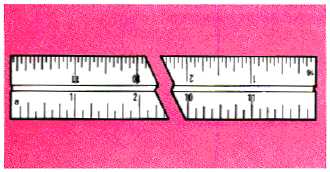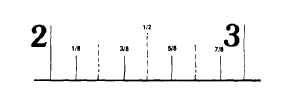TM 9-243
CHAPTER 3 READING MEASURING SCALES
The following chapter is designed to provide a basic
understanding of how to read scales, dials, and gages.
It will not provide any information on the actual use of
the tools. Reference to this chapter will be made
throughout the remainder of the manual.
INDEX
Item
Page
Reading the scale of a rule or tape........ 3-1
Reading a metric rule ............................ 3-3
READING THE SCALE OF A RULE OR TAPE
The more common type rules and tapes are divided into
fractions, inches, and feet. Explained here are the
scales on a 12-inch steel machinist's rule.
The rule is divided into twelve inches. The inches are
further divided into eighths, sixteenths, thirty-seconds,
and sixty-fourths.
Look at the rule. There is a small numeral marked on
the end of the rule nearest the 1-inch mark. This
numeral indicates the number of divisions per inch.
When referring to fractions, always use the reduced
name. This is the smallest numerator (top number) and
denominator (bottom number). For example, 3/6 can be
reduced to 1/2 by dividing both the top and bottom by 3.
Generally, fractions may be reduced to their lowest
forms by repeated division by 2 or 3.
Look at the section between the "2" and the "3" on the
edge marked with an "8" for eighths.
There are eight equally spaced lines. The lengths of
these lines differ and indicate different fractions or parts
of an inch.
The longest line is in the center and is equal to 4/8 or ½
inch.
Each half-inch is divided in half by a slightly shorter line
indicating 2/8 or 1/4 on the left and 6/8 or 3/4 on the
right.
Each 1/4 inch is divided in half by the shortest line which
indicates 1/8 inch, and will indicate 1/8, 3/8, 5/8 and 7/8.
3-1









